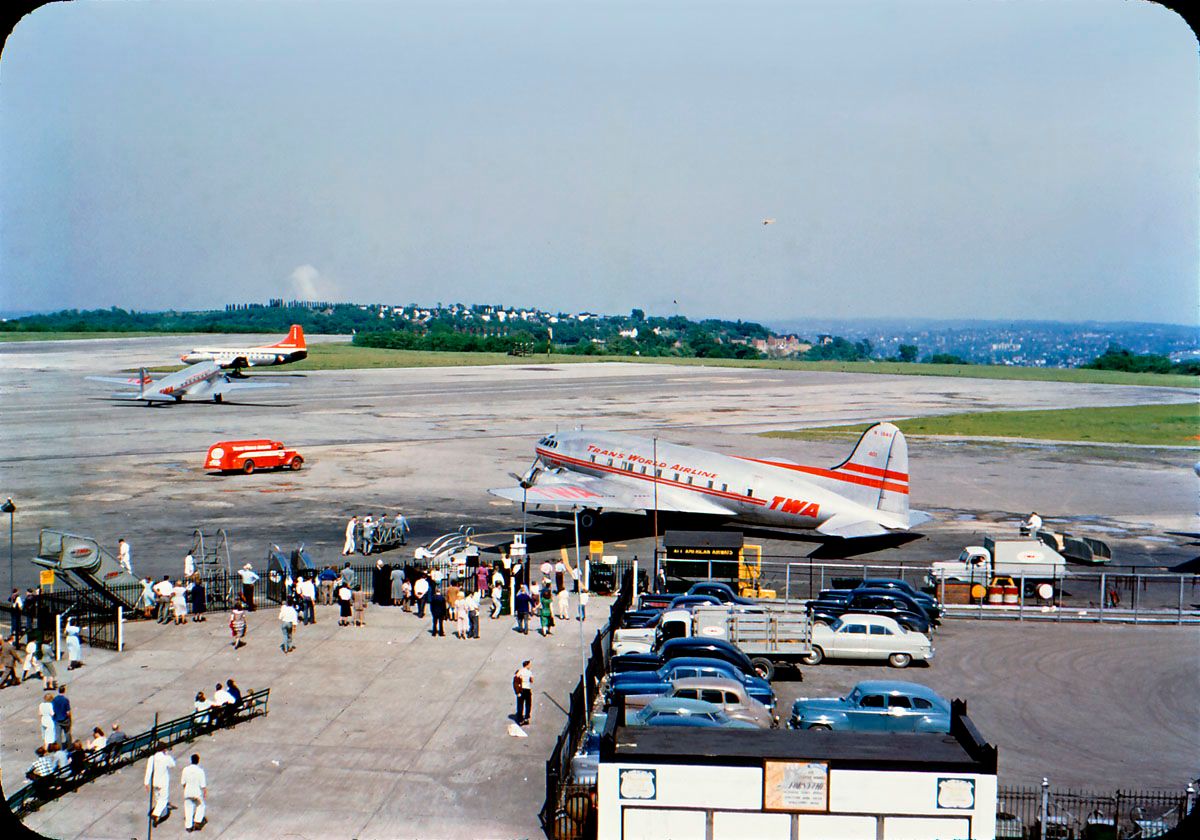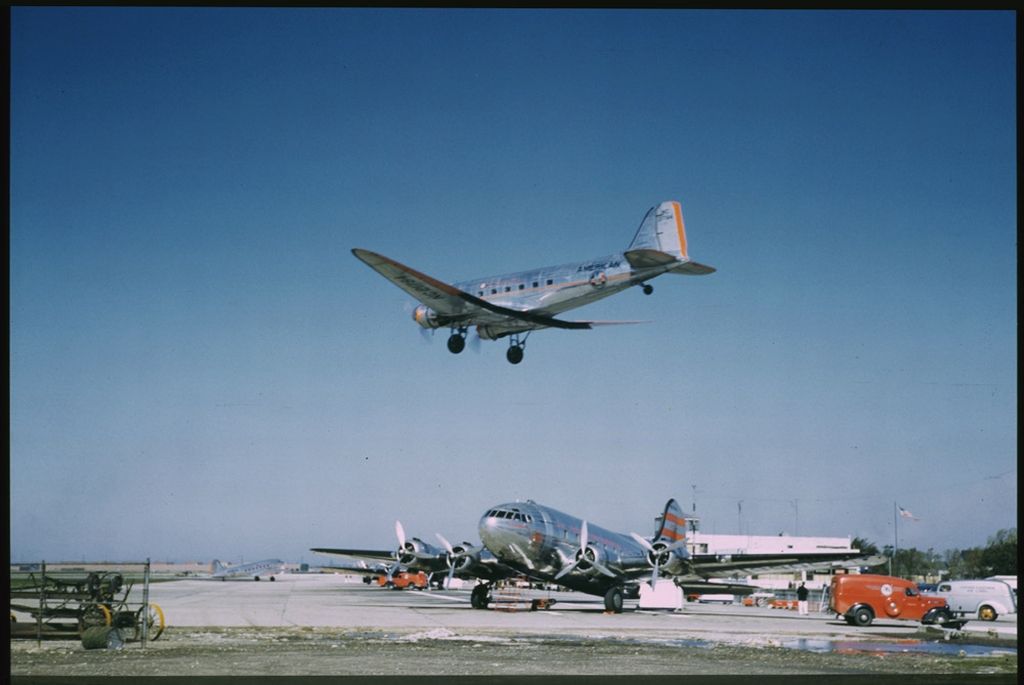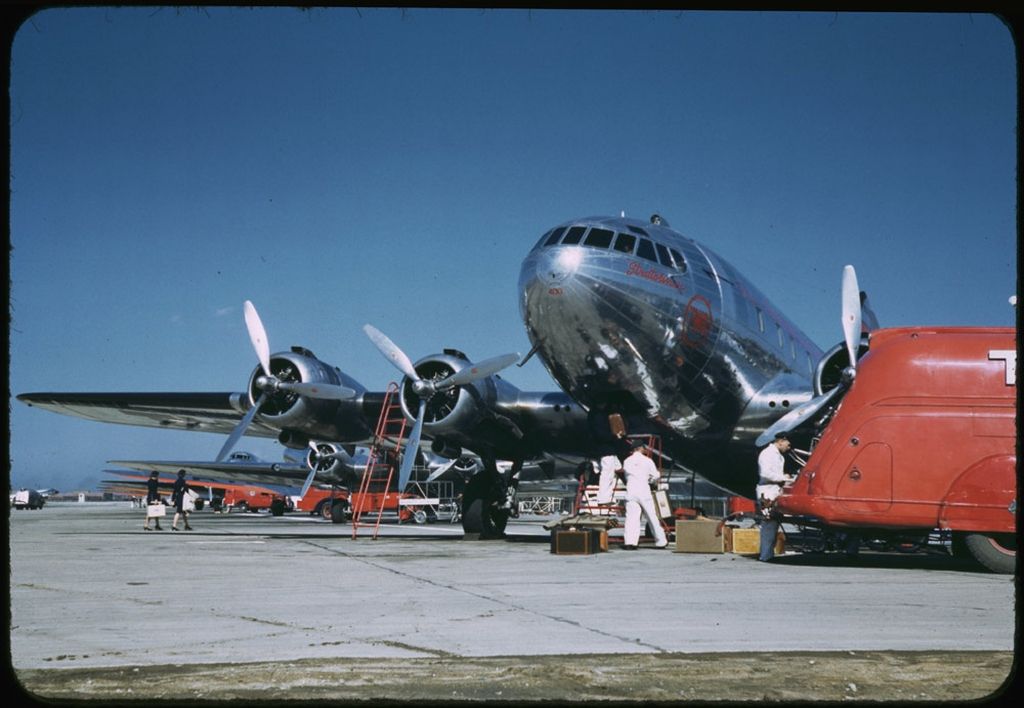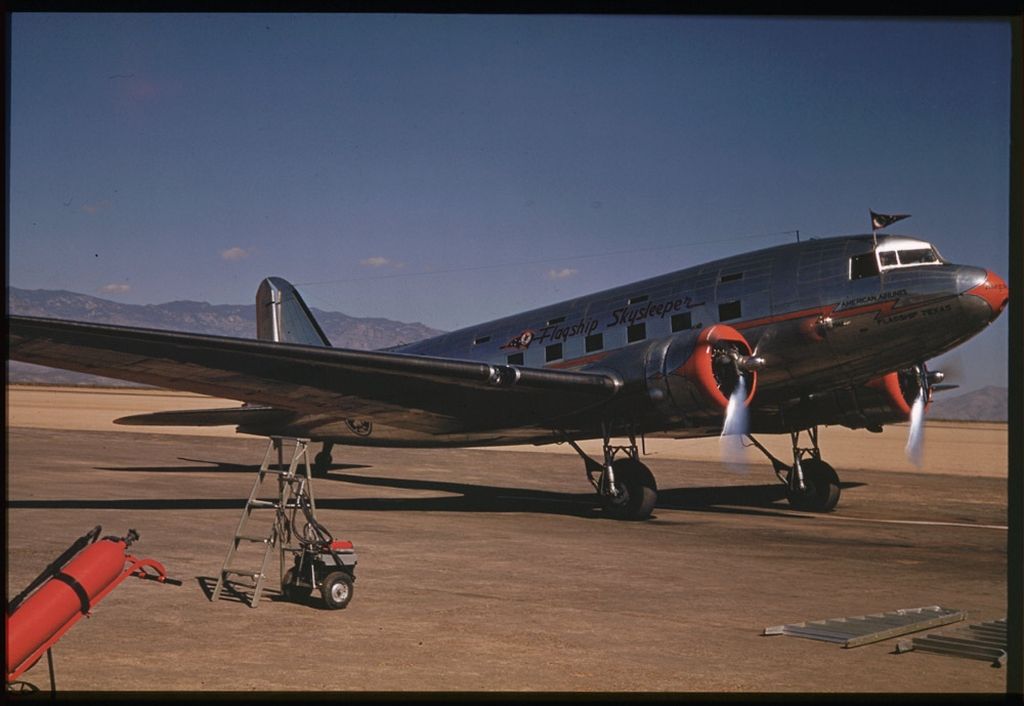When a C-75's military career is over ...
Sat Dec 19, 2015 4:11 pm
... it's stripped and converted back to a TWA 307 stratoliner? ...

C-75 "Comanche"

Boeing 307 Stratoliner converted to C-75 "Cherokee"

C-75 converted back to a Boeing 307 Stratoliner (at least what it looks to be happening by what's going on in this photo)

A nice clean Boeing 307 Stratoliner (not the same airplane as the one being stripped above)
A little Wiki history:
In 1935 Boeing designed a four-engine airliner based on its B-17 heavy bomber (Boeing Model 299), then in development, calling it the Model 307. It combined the wings, tail, rudder, landing gear, and engines from their production B-17C with a new, circular cross-section fuselage of 138 in (351 cm) diameter, designed to allow pressurization.
The first order, for two 307's (named Stratoliners), was placed in 1937 by Pan American Airways; Pan Am soon increased this to six, and a second order for five from Transcontinental & Western Air (TWA), prompting Boeing to begin production on an initial batch of the airliner.
C-75 conversion
At the time the United States entered World War II in December 1941, flying across oceans was a rare luxury. The war required government and military officials to do so and most four-engined long-range commercial aircraft, including Pan American Airways' 14 flying boats and TWA's five Boeing 307s, were pressed into service. Additional fuel tanks were added to give them the extra range required; once converted they were designated C-75 for military use. Before World War II ended their production, ten commercial 307s had been built. TWA flew domestic routes between New York and Los Angeles for 18 months until the Army purchased their Stratoliners for wartime use as long-range, transatlantic transports for various VIPs or critical cargo. TWA converted their 307s to military service in January 1942, and its Intercontinental Division (ICD) then operated these C-75s under contract to the Army's Air Transport Command (ATC) until July 1944. These were the only U. S. built commercial aircraft able to cross the Atlantic with a payload until the arrival of the Douglas C-54 Skymaster in November 1942.
Conversion to the C-75 included removal of the pressurization equipment to save weight, removal of the forward four (or five) of nine reclining seats along the port side, and alteration of the two forward Pullman-like compartments (of four) starboard of the left-of-centerline aisle. Space was thus provided for crew requirements on extremely long flights and for the addition of five 212.5 U.S. gal (804 L; 177 imp gal) fuel tanks. The landing gear was strengthened, the maximum takeoff weight was increased from 45,000 to 56,000 lb (20,400 to 25,400 kg)), and the exterior painted military olive drab.
Variants
300
original concept designation of 307.
307
equipped with Wright Cyclone GR-1820-G102 engines with single speed supercharger; five crew.
307B
equipped with Wright Cyclone GR-1820-G105A engines with two-speed supercharger for improved high altitude performance; seven crew.
C-75
Five Trans World 307Bs were pressed into service with the USAAF as military transports; the cabin pressurization was removed to save weight.
307B-1
Following military service, the C-75s were overhauled and updated with B-17G wings and tailplane, four Wright Cyclone GR-1820-G606 engines, and B-29-type electronics.

Boeing 307 original concept

Boeing 307 original concept

Boeing 307 original concept

Boeing 307 original concept

C-75 "Comanche"

Boeing 307 Stratoliner converted to C-75 "Cherokee"

C-75 converted back to a Boeing 307 Stratoliner (at least what it looks to be happening by what's going on in this photo)

A nice clean Boeing 307 Stratoliner (not the same airplane as the one being stripped above)
A little Wiki history:
In 1935 Boeing designed a four-engine airliner based on its B-17 heavy bomber (Boeing Model 299), then in development, calling it the Model 307. It combined the wings, tail, rudder, landing gear, and engines from their production B-17C with a new, circular cross-section fuselage of 138 in (351 cm) diameter, designed to allow pressurization.
The first order, for two 307's (named Stratoliners), was placed in 1937 by Pan American Airways; Pan Am soon increased this to six, and a second order for five from Transcontinental & Western Air (TWA), prompting Boeing to begin production on an initial batch of the airliner.
C-75 conversion
At the time the United States entered World War II in December 1941, flying across oceans was a rare luxury. The war required government and military officials to do so and most four-engined long-range commercial aircraft, including Pan American Airways' 14 flying boats and TWA's five Boeing 307s, were pressed into service. Additional fuel tanks were added to give them the extra range required; once converted they were designated C-75 for military use. Before World War II ended their production, ten commercial 307s had been built. TWA flew domestic routes between New York and Los Angeles for 18 months until the Army purchased their Stratoliners for wartime use as long-range, transatlantic transports for various VIPs or critical cargo. TWA converted their 307s to military service in January 1942, and its Intercontinental Division (ICD) then operated these C-75s under contract to the Army's Air Transport Command (ATC) until July 1944. These were the only U. S. built commercial aircraft able to cross the Atlantic with a payload until the arrival of the Douglas C-54 Skymaster in November 1942.
Conversion to the C-75 included removal of the pressurization equipment to save weight, removal of the forward four (or five) of nine reclining seats along the port side, and alteration of the two forward Pullman-like compartments (of four) starboard of the left-of-centerline aisle. Space was thus provided for crew requirements on extremely long flights and for the addition of five 212.5 U.S. gal (804 L; 177 imp gal) fuel tanks. The landing gear was strengthened, the maximum takeoff weight was increased from 45,000 to 56,000 lb (20,400 to 25,400 kg)), and the exterior painted military olive drab.
Variants
300
original concept designation of 307.
307
equipped with Wright Cyclone GR-1820-G102 engines with single speed supercharger; five crew.
307B
equipped with Wright Cyclone GR-1820-G105A engines with two-speed supercharger for improved high altitude performance; seven crew.
C-75
Five Trans World 307Bs were pressed into service with the USAAF as military transports; the cabin pressurization was removed to save weight.
307B-1
Following military service, the C-75s were overhauled and updated with B-17G wings and tailplane, four Wright Cyclone GR-1820-G606 engines, and B-29-type electronics.

Boeing 307 original concept

Boeing 307 original concept

Boeing 307 original concept

Boeing 307 original concept
Re: When a C-75's military career is over ...
Sat Dec 19, 2015 7:14 pm
Where is the DELETE button??
Last edited by Cubs2jets on Sat Dec 19, 2015 7:35 pm, edited 1 time in total.
Re: When a C-75's military career is over ...
Sat Dec 19, 2015 7:14 pm
TWA paid Boeing $2 Million to overhaul and upgrade their 307's when they got them back from the Army. Upgrades included B-17G wings / engines and tail and an upgraded electrical system. TWA operated the B307's until 1951. Here is a nice picture of one at KAGC (Pittsburg Alleghaney County) sometime between 1947 and 1951. (Northwest received its Martin 202's in 1947.)

C2j

C2j
Last edited by Cubs2jets on Sat Dec 19, 2015 9:37 pm, edited 3 times in total.
Re: When a C-75's military career is over ...
Sat Dec 19, 2015 7:14 pm
Double post.
Re: When a C-75's military career is over ...
Sat Dec 19, 2015 7:50 pm
Great shot, I don't think I've ever seen a TWA 307 in that late of a photo. God to see they got some use out of them post war.
Re: When a C-75's military career is over ...
Sat Dec 19, 2015 8:10 pm
Well, this is interesting. From the same Wiki:
From Aviation Safety Network:
http://aviation-safety.net/database/rec ... 19750313-1
Has it been seen since - or has anyone looked for it?
On March 13, 1975, a Royal Air Lao Boeing 307B-1 (XW-TFP) force-landed in the Mekong River in Laos while on a Hong Kong-Vientiane cargo service; both pilots (who survived) were held prisoner by the Pathet Lao for several months before being released in May 1975. The aircraft was located in 1986.
From Aviation Safety Network:
MacAlan Thompson reported that a Stratoliner was forced to carry out a controlled crash-landing in a river. ... Since Stratoliner XW-TFP was seen in the Mekong river, near the Laos-Thailand border in 1986, this is probably the aircraft that "disappeared".
http://aviation-safety.net/database/rec ... 19750313-1
Has it been seen since - or has anyone looked for it?
Re: When a C-75's military career is over ...
Sun Dec 20, 2015 9:45 am
Nice photos! 

Re: When a C-75's military career is over ...
Sun Dec 20, 2015 10:29 am
Cubs2jets wrote:TWA paid Boeing $2 Million to overhaul and upgrade their 307's when they got them back from the Army. Upgrades included B-17G wings / engines and tail and an upgraded electrical system. TWA operated the B307's until 1951. Here is a nice picture of one at KAGC (Pittsburg Alleghaney County) sometime between 1947 and 1951. (Northwest received its Martin 202's in 1947.)
C2j
To help date this photo... there's a 1950 Ford sedan visible in the picture. It's the white car parked below the tail of the 307.
Re: When a C-75's military career is over ...
Sun Dec 20, 2015 12:58 pm
Re: When a C-75's military career is over ...
Sun Dec 20, 2015 3:59 pm
Love the AA DC-3. Straight out of Ernie Gann's Fate is the Hunter.
Re: When a C-75's military career is over ...
Sun Dec 20, 2015 10:18 pm
It's not a DC-3...
C2j
C2j
Re: When a C-75's military career is over ...
Sun Dec 20, 2015 11:11 pm
Did the conversion of the C-75s (8 no?) back to 307s include restoring the pressurisation the I have read was removed for military use?
The windows look very rectangular in the light of the issues with the rectangular cutouts in the Comet 1 though construction techniques played a part in the Comet failures and the jet could go through larger pressure cycles much faster.
The windows look very rectangular in the light of the issues with the rectangular cutouts in the Comet 1 though construction techniques played a part in the Comet failures and the jet could go through larger pressure cycles much faster.
Re: When a C-75's military career is over ...
Mon Dec 21, 2015 11:30 am
Great thread with great pics. Thanks for posting!
Re: When a C-75's military career is over ...
Mon Dec 21, 2015 4:58 pm
Cubs2jets wrote:It's not a DC-3...
C2j
As is obvious from the painted titles above the windows.
I didn't want to confuse people by calling it a DST-G2. (or G102 or G202A depending on the engines. If I knew the NC number of Flagship Texas, I could tell you).
Besides, no one has called them a DST for the last 75 years...even in service AA crews just called them "Sleepers".
Re: When a C-75's military career is over ...
Mon Dec 21, 2015 8:01 pm
That's NC14988 American Airlines Flagship Texas photographed at KTUC (Tucson).
NC14988 (originally X14988) is the prototype DST. Served with American Airlines from July 1936 to October 1942. Sold(?) to TWA and was converted to C-49E 42-43619 and operated for USAAF. Written off Knobnoster, MO 15 October 1943 - circumstances unknown.
C2j
NC14988 (originally X14988) is the prototype DST. Served with American Airlines from July 1936 to October 1942. Sold(?) to TWA and was converted to C-49E 42-43619 and operated for USAAF. Written off Knobnoster, MO 15 October 1943 - circumstances unknown.
C2j





